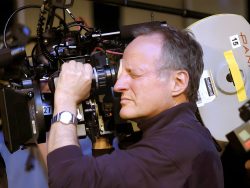We all know it’s our deadly passion, our terrible joy. But if you get into one of my cars —
and no one is forcing you to take that seat —you get in to win – Enzo Ferrari
Enzo Ferrari was a flawed perfectionist who invented the iconic sports car that bears his name. His passion for car racing prevailed even when the pervasive threat of a fatal accident lingered every time one of his cars hit the race track. The film outlining his life was based on the 1991 book Enzo Ferrari: The Man, The cars, The Races, The Machine by Brock Yates and adapted into a screenplay by Troy Kennedy Martin (The Italian Job – both 1969 and 2003 versions, The Edge Of Darkness). Both these men have since passed, but director Michael Mann (Heat, Miami Vice) told us about his movie of an obsessed ex-racer whose car won the Mille Miglia, the dangerous thousand mile race track during post-War Italy in 1957.

Michael Mann
“The project began in the 1990s soon after the book was published, and Sidney Pollock was approached in 2015 to make the film,” recalls Michael Mann. “Sidney’s influence is felt in the final version with the romanticism and the passion of the sport and era. Ferrari was a torturous road to production. It’s opportunistic, from a narrative sense, that in those three months of his life on which the film is based, all these emotional and dramatic elements of four months of Ferrari’s life came into play in a crucible,” he continues.
Mann’s goal was to deep dive into the inner lives of Enzo Ferrari (Adam Driver) and those surrounding him to balance character intimacy with high-octane racing. He didn’t want the audience to judge Ferrari, but to understand him as a flawed person.
Ferrari opens with a family in financial and emotional distress. Enzo needs to sell substantially more cars or face impending bankruptcy. He’s in a constant state of anxiety and agitation. Their public and private lives are displayed for all to see. Enzo and his wife Laura (Penélope Cruz) are still grieving from the premature death of their son Dino from muscular dystrophy a year earlier, putting an even greater strain on their volatile marriage.
The director balanced the conflicts with the media, his financiers, his affairs, his troubled marriage, and his secret family. All this was set against the backdrop of the one thing that allowed Enzo to experience a blissful escape – car racing. “I wanted to bring the audience inside the car and have the experience of the agitation of what it is when you’re on the absolute edge,” says Mann.
A Character Of Dualities
Ferrari’s home life could only be described as “complicated.” “Enzo’s story has a wonderful duality, the counterpoint within Enzo of two or three different kind of personalities. He’s a car maker, husband, son, and father. The duality and the contradiction of his relationship with his wife Laura exits because they can’t be apart and they can’t be together. There’s hostility, but also a conjugal partnership.” Enzo was both rational and measured at irrational and impulsive in his life.
Many films end with some sort of resolution with their conflicts, but not Ferrari. “The story was able to be structured and have a conclusion with the characters still unresolved and they continue to be for a long time,” says Mann.
Enzo and Laura have a conflicted marriage because they have different world views. Laura cannot convince Enzo to abandon his money-losing death-dying venture. She’s beyond caring about his infidelities. Enzo’s woes do not end there.
“He’s responsible for the death of his son Dino because he was distracted. He had another woman Lina Lardi (Shailene Woodley) who he met during the war and she bore his secret son Piero (Giuseppe Festinese) who now seeks recognition from his father and adoption of the Ferrari name.” During that time, Lina only wanted to raise her son in a stable household.
“Enzo is an instigator of men, a precise engineer, and a race car driver with an addiction. We saw his ledgers and his diaries. Everything in them is totally rational, and to a purpose, when it has to do with racing. In the rest of his life, he’s libidinous, he’s chaotic, and there’s no rudder,” continues Mann.

Laura Ferrari (Penelope Cruz) Photo courtesy of Neon
Enzo never questioned whether he should race cars, but rather asked, “Why wouldn’t I?” He was as meticulous as he was obsessive often making painstaking and expensive adjustments to his cars so they would race half a second faster.
Who Shall I Be In This World?
“The core of Enzo is a young man who was around 19 years old in 1918, sitting on a park bench in a rain, having just been turned down by a Fiat for a job. His father died a year ago, his brother died soon after, and he’s bereft. And he asked himself one question, ‘Who shall I be in this world?”
Mann adds that Ferrari had a highly-romanticised version of his tumultuous life. He had to transcend his guilt and grief of family tragedy and the rigid social and business hierarchy of post-War Italy. It was inconceivable that his upstart family business could challenge the supremacy of Maserati with their virtually-guaranteed sponsorships and bank loans.
Ferrari initially opted for a career as an opera singer, but he couldn’t sing very well. A race car driver was his backup plan. Racing was every boy’s dream job much like becoming an astronaut was after Neil Armstrong took his first steps on the moon.
No-one else can appreciate the depth of Ferrari’s ecstatic passion and addiction when everything’s harmonic and working in a race car. Even when one his drivers Alfonso de Portago (Gabriel Leone) is killed in an accident, he persists. Ferrari’s attitude to life is that “no matter how successful something is, tragedy can defeat a competitor right around the corner.”
Enzo was a ruthless automotive genius where casualties were viewed as unfortunate collateral damage, but also a tender, vulnerable, and tortured soul who was aware of his failings and sometimes sought counsel from his dead son. Ferrari had bouts of emotionally-detachment from his family, his employees, and his associates as he planned his global Ferrari takeover. He was unflinching from his vision to build the world’s fastest car – both his blessing and his curse.
Mann spent a lot of time with Enzo’s son Piero who is currently the Vice-Chairman of the Ferrari Automotive Company.
While Enzo carried an aura of mystique with him, Laura was extroverted, vivacious, and fun in their early years. She’s the fire in Ferrari and he’s the ice. They met when she was a cabaret singer in 1922. Although his feelings for her changed over time, he never stopped loving her despite his philandering. Their marriage was as romantic as it was operatic. They still exchanged romantic love letters even when they were estranged.
Post-War Italy was gripped with nostalgia and art. Ferrari was obsessed with beauty and form. Mann references the Italian opera La Traviata by Verdi where a father talks his son into abandoning the woman he loves because she’s of too low a class. Later he has deep regrets.
“Things are out of sync in the opera just the way they are out of sync in his life. There’s a certain parallel to what we did. There’s these very realistic emotional situations, but they’re expressed in such an overwrought way that they descend on us and they make us think,” explains Mann.
The director insisted on practical car racing for most of the movie instead of CGI. Mann raced as an amateur racer in a Ferrari Challenge for about six years so he has an appreciation of the world. “There was an organic unified sense of myself and the car. We were all one organism.”
Despite his eventual success in revolutionising the racing car industry, Ferrari was also aware of his legacy in the face of nearly bankrupting his company and his advancing age. His life was always tenuous and unpredictable, but always memorable.
